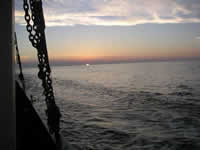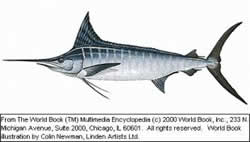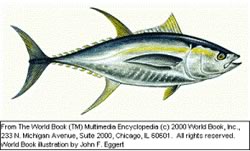


|
The Project Part 1: Part 2: Part 3:
|
04 August, 2005
|
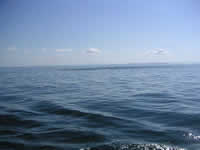 Tuna Boil outside of Guaymas 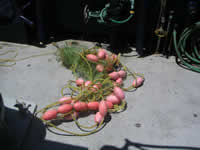 Another threat to marine life, abandoned fishing gear 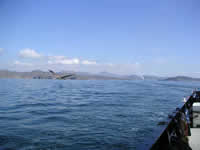 Pelican 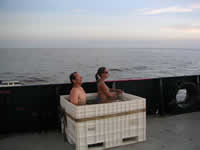 Brian and Elisa “hot-tubbing” on the back deck |
We’re not allowed to fish while we’re in the Gulf of California because we don’t have Mexican fishing licenses. The crew is pretty disappointed and the subject comes up daily, spoken of with deep regret, especially when these magnificent (and tasty) fish make an appearance.
In The Log from the Sea of Cortez, Steinbeck, Ricketts and the crew relied on their ability to catch fish to supplement their diet during their six week-voyage. The fishing boat they traveled on, The Western Flyer, had no refrigeration, and was too small to stock with adequate food. They caught skipjack (a type of tuna), and other types of tuna, tried to catch swordfish, but never did, and dined on bonito (of the mackerel family). But most of all they relished the Mexican sierra, a “golden fish with brilliant blue spots,” whose “meat is white and delicate and sweet. Simply fried in big hunks, it is the most delicious fish of all.”
Six decades later, the situation is very different in the Sea of Cortez. The shrimp fishery near Guaymas is in great decline; fishermen are now fishing squid, hoping to make a living. But squid doesn’t pay near as well as shrimp. In 1940, Steinbeck foresaw the crash in shrimp fishing; he remarked on foreign trawlers that were “rapidly destroying the species so that it may never come back.” It is estimated that 80% of the wetlands in the Colorado River estuary have been destroyed due to damming and diversions of water to the southwestern USA. Estuaries are important breeding grounds for many types of marine life, especially for adult shrimp, who go there to lay eggs. Tourists flock to Baja; many haul out ice chest after ice chest filled with fish. Some speculate that the large amounts taken are not recreational, but are in fact commercial catches. The swimming crab or jaiba fishery, which began about 20 years ago, is already in serious decline. Pollution and agricultural run-off threaten many species of birds and marine mammals. The giant sea bass, or totoaba, is critically endangered, as are 55 other terrestrial and marine Gulf species.
The Gulf of California is well-known for its great biodiversity; the seas here are home to 891 species of fish, 181 species of marine birds, 34 species of marine mammals, 6 species of marine reptiles and 4,853 species of marine invertebrates.
The Gulf of California plays a significant role in Mexico’s economy. Nine percent of the Mexican population lives in the Gulf region. The Gulf’s fisheries account for 57% of the total value of fisheries in Mexico. 40% of Mexico’s agricultural output occurs in the Gulf region. The population growth rate in the region is much higher than the national average. La Escalera Nautica, a series of marinas being built off Baja, threatens vital marine resources. Many people believe that poorly-planned economic development poses the greatest threat to the ecological health of the Gulf region.
Much of this information comes from the Gulf of California Conference held in Tucson, Arizona in the summer of 2004.
Math Problem:
The cooks stocked the boat with 72 dozen eggs. How many eggs is that? With 31 people onboard, how many eggs are each of us allotted?
Trivia Tidbit of the Day:
Cuttlefish is a soft, boneless animal related to the squid. The cuttlefish has an internal shell called the cuttlebone. The shell-like material is porous and chalky. It is often used in making toothpaste.
![]()

